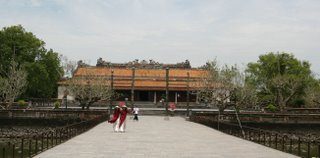Greetings from the South China Sea
 Moving around day to day is par for the course in seeing bits and pieces of the world, but once in awhile it’s nice to take a break from the constant packing and repacking and the repeated bus/car/train/moto/plane/cyclo rides. For those wishing to get away from it all in Vietnam, Hoi An offers a beautiful beach setting and town on the South China Sea.
Moving around day to day is par for the course in seeing bits and pieces of the world, but once in awhile it’s nice to take a break from the constant packing and repacking and the repeated bus/car/train/moto/plane/cyclo rides. For those wishing to get away from it all in Vietnam, Hoi An offers a beautiful beach setting and town on the South China Sea. Known for its tailors and art galleries, five hundred fifty kilometers south of Hanoi, Hoi An has many spots for vacationers looking to get away from it all. The upside is that you can bring your family, kids et al, the downside is that you can bring your family and the fact that if you do not leave your beachside hotel, you could be anywhere from Hawaii to the Carribean to the Greek Isles. Step into any one of the beachside resorts and a polite service oriented atmosphere with an infinity pool set ten meters off the beach awaits.
Traveling through India and Hanoi on a lower budget, arriving in Hoi An at the Victoria Resort was reverse comfort shock. As if finding an oasis in the desert, my eyes and stomach feasted upon the trays of fresh fruit, the varied Vietnamese and western breakfasts, beyond Pho and Mi Tom (local noodle dishes) and the multi-stationed dinner buffet. With temperatures ranging from 90 to 95 degrees with what felt like 100% humidity, the AC, pool and private beach provided welcome relief. I was happy to kick back for a few days finding a mini-vacation from the road before Jason returned to the states.
But staying in comfort has its drawbacks too. Thus far, for most of the trip, my days have been packed full of seeing points of interest, visiting historic sites and navigating my way around a new unfamiliar city/town/village. Presented with all of the creature comforts, our motivation to spend 4+ hours in a car to see the tourist spots dwindled to a standstill in exchange for some visits to a tailor and many art galleries. Still thirsty for our independence, we rented two motorbikes for the duration of our stay in Hoi An, a respite from putting ourselves at the mercy of many unknown drivers carting us hundreds of kilometers throughout the country.
Prior to our 130 kilometer ride to the edge of the S. China Sea, the former imperial seat of Vietnam, Hue (pronounced “Who way”), served as our home for touring historic military sites from the Vietnam War. The city of Hue itself was the stage for one of the bloodiest battles during the war, the Tet Offensive. It was the only S. Vietnamese city to be occupied by the N. Vietnamese Army for more than a few days during the war. Under twenty-five days of occupation, the N. Vietnamese Army conducted house to house searches pulling more than 3,000 suspected S. Vietnamese government supporters from their homes resulting in their clubbing, shooting or live burial in mass graves.
 (Partial view of former Imperial Palace.)
(Partial view of former Imperial Palace.)It was also from the streets of Hue that the first images of Thich Quang Duc, a Buddhist monk, setting himself ablaze in protest of the religious persecution by the S. Vietnamese Diem government (supported by the US) that caught the attention of the world media circuit in 1963. Such images were seen around the world and later would be copied by others monks and nuns across Vietnam more than a dozen times, sometimes in protest of the war and other times protesting the lack of religious freedom. Regardless of the motivation, pictures of the flames engulfing the robed bodies would become permanently emblazoned in the American conscience.
 (Thich Quang Duc immolates himself.)
(Thich Quang Duc immolates himself.)More than forty years later, Hue is now a town of commerce and tourism, drawing hundreds of tourists to the old Imperial Palace (mostly destroyed by bombs in the war with the French and later US) each day. The scars of the war may run deep, but they are not visible at the surface or in the kind smiles of the city's residents. And as for Thich Quang Duc, there is no memorial or marker at the intersection where he took his own life, all that remains is the dramatic image in the collective mind's eye of the world.


<< Home